#now in the Museo de América Madrid
Text
For #GuineaPigAppreciationDay, here are two Chimú polychrome effigy vessels in the form of guinea pigs, North Coast Peru, 1100-1400 CE, now in the Museo de América Madrid collection. Both feature split-color black and white faces so there are three views of each.
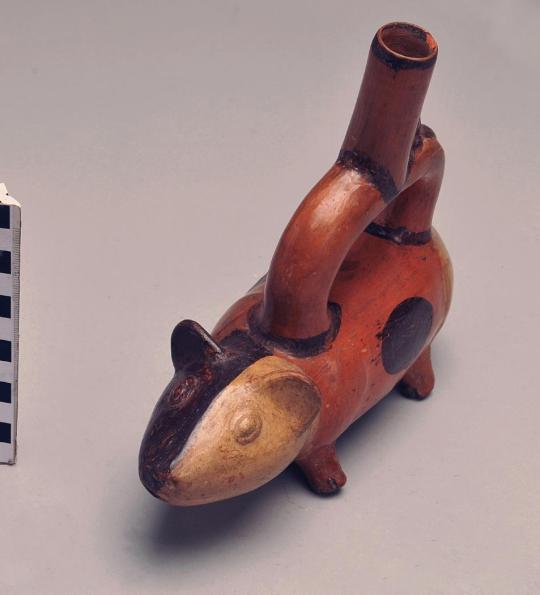

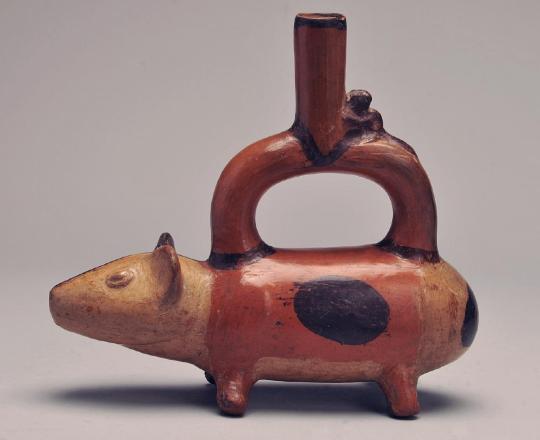
Inv. 10217 (3 views)
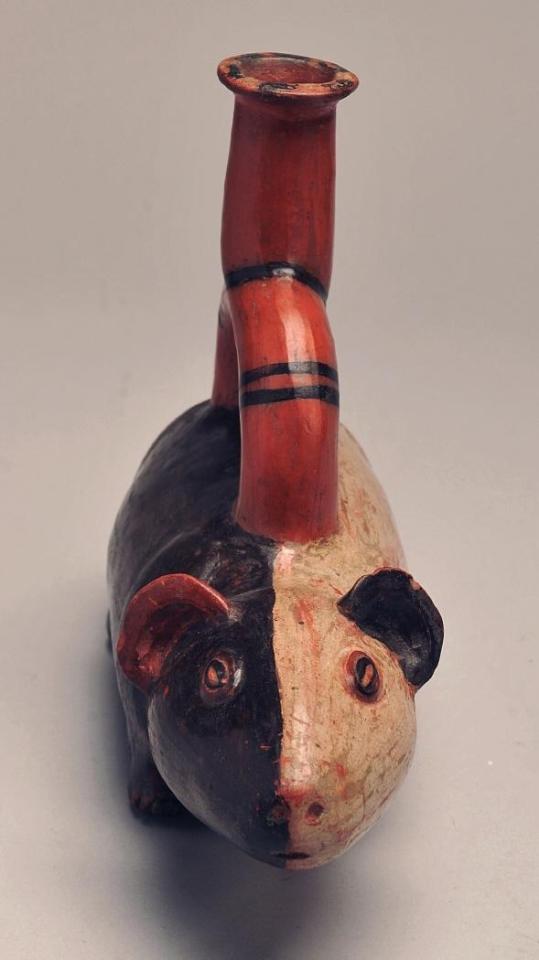

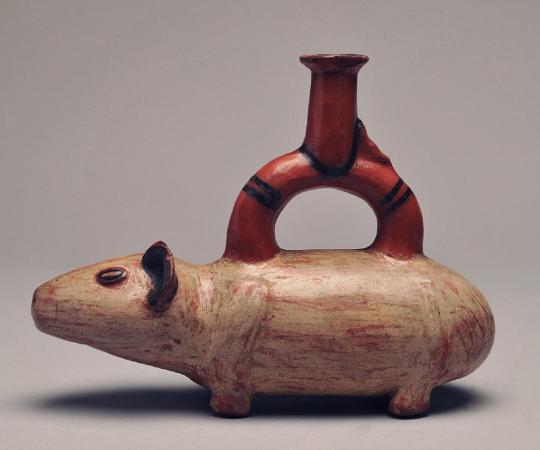
Inv. 10297 (3 views)
#Chimú art#Peruvian art#South American art#Indigenous art#animal holiday#Guinea Pig Appreciation Day#ceramics#effigy vessel#now in the Museo de América Madrid#polychrome#guinea pig#guinea pigs#cavy#cavies#animals in art#pre conquest art
414 notes
·
View notes
Photo

Camelid figurine
Date: 1400–1533
Geography: Ecuador, Peru, Bolivia, Chile, or Argentina
Culture: Inca
Medium: Alloys of silver, gold and copper
This male camelid figurine, potentially representing a llama, has a solid head and a hollow body. While many similar camelid figurines are made of hammered sheet, X-radiography confirms that this figurine was cast by the lost wax method (see image 3) in two distinct casting stages to achieve different metallic effects. The first step was the casting of the llama’s head (see image 4), neck, torso (see image 5), and tail (see image 6), as well as its legs, with a silver-copper-gold alloy. As part of this first step, the wax form of the torso was modelled around a ceramic core that now forms a hollow space within the camelid’s body (the space is not visible to the viewer as it has been covered over by a silver metal plug at the chest, visible in the X-ray). The second casting step was the creation of the head and upper or rear elements of the body and tail in a more gold-rich silver metal. This second casting operation was accomplished by casting directly onto the solidified silver-rich portions.
X-radiography reveals extensive porosity throughout most of the silver metal areas, a feature caused by gas trapped in the molten metal during casting, which contrasts with a lack of porosity in the gold-rich areas. This difference suggests that the second step in casting may have been undertaken to correct flaws or areas of weakness associated with the porosity in the first. XRF analysis of the two metal elements indicates that the silver-rich metal contains approximately 72% silver, 20% copper and 7% gold while the more gold-rich areas contain roughly 50% silver, 42% gold, and 8% copper. Following casting, the metal worker employed tracing and engraving tools to form the details of the inner ear, the eyes, the nostrils, the mouth, and the toes.
The object may be considered a huaca, a Quechua and Aymara word for a sacred being among Andean peoples. Huacas may take the form of artificial anthropomorphic or zoomorphic objects, as well as rocks, mountains, and mineral sources (Cruz 2009). Throughout the Andes, camelids, including two wild and two domesticated species, are prized for their wool and meat (Moore 2016). For the Incas, their human ancestors, along with camelids, were thought to have come into existence from a cave at Pacariqtambo. In the Andes, camelids, whose hides and bones were turned into a range of products, are charged with carrying goods as part of caravans.
Camelid figurines may be components of the Inca ritual performance of capac hucha, a Quecha term meaning ‘royal obligation’, in which, according to 16th century Spanish chroniclers (Cieza de León 1959, 190-193; Diez de Betzanos 1996, 46, 132), could involve annual celebrations in Cusco where prophecies were given for the coming year as well as sacrificial offerings of llamas, maize, and children, whether as a dedication to the Sun or for particular royal events, including the Sapa Inca’s death. As part of this performance, in some cases, juveniles were ritually married in Cuzco and then sent on processions to points as far north and south as Isla de la Plata in Ecuador and Cerro El Plomo in Chile, respectively, where they were sacrificed and buried, wearing textiles, and accompanied by dressed metal and Spondylus spp. shell figurines, ceramic vessels, and other shell and metalwork. The motivation of the capac hucha was to commemorate particular royal events and to mark the expansion of the Inca Empire. However, such figurines may have been deposited with other intentions, and without human burials. In one case, four camelid figurines in metal and shell were recovered in a line oriented to the southeast and in association with stones related to the usnu, or altar, of Cuzco as part of the dedication of sacred space in the Haukaypata, or main plaza of Cuzco (Farrington and Raffino 1996, 73). Camelid figurines were occasionally designed with special ornamentations, such as those seen on two figurines from the region of Lake Titicaca, including the attachment of a textile blanket adorned with gold appliqué and cinnabar (AMNH B/1618) and a highly corrugated surface to index the texture of the animal’s pelage (AMNH B/1619). These ornamentations, or inherent aspects of the design of the figurines, testifies to the ways that metallurgists distinguished their ritualized work. At present, there is little archaeological indication of production sites for these figurines, but Spanish chroniclers point to Cuzco. Many Inca camelid figurines in metal tend to be around the height of 1974.271.36, but there are exceptions (such as the two aforementioned AMNH figurines) that are larger, at 23–24 cm. The height groupings of the camelid figurines are in some way comparable to those of the Inca anthropomorphic figurines in metal but appear to show a bipartite rather than a tripartite grouping (see McEwan 2015, 282, n. 15). In Spondylus spp., the heights of camelid figurines may range from approximately 2 to 7 cm without clear groupings across that range.
It should be recognized that many of the sites from which these figurines have been recovered are sacred to local indigenous communities (see Aguero 2004, Fine-Dare 2009, and Politis 2001 on the display of human remains from the mountaintop capac hucha site of Llullaillaco in Argentina). Eleven camelid figurines in silver, gold, and Spondylus spp. were associated with the human male juvenile’s grave at Llullaillaco but none was found with the two human female graves (MAAM 2007, 52). A hollow camelid figurine, made of gold-silver-copper sheets joined mainly by solder, was recovered from the capac hucha burial of a 7-year-old human male at Cerro Aconcagua, also in Argentina (Bárcena 2004). While camelid figurines are often found with male capac hucha burials (King 2016), a strict gender correlation is not clear. At Choquepujio, in the Cusco Valley, a Spondylus male camelid figurine was found resting in a Spondylus valve associated with the Inca burial of a female juvenile (11–12 years old) inside a pre-Inca temple (Gibaja et al. 2014). In excavating a burial of a male juvenile (6–7 years old), investigators recovered two Spondylus female camelid figurines. In these assemblages, camelid figurines were social actors, having their own camay, a Quechua term that could be translated as “energizing power,” through interaction with other assemblage components and with the human actors that made and deposited them. The deterioration of these objects, or their removal from their original locations in the earth, has surely changed their efficacy.
Technical notes: Optical microscopy, new X-radiography, and XRF conducted in 2017.
Bryan Cockrell, Curatorial Fellow, AAOA
Beth Edelstein, Associate Conservator, OCD
Ellen Howe, Conservator Emerita, OCD
Caitlin Mahony, Assistant Conservator, OCD
2017
Further Reading
Aguero, Adrian. Violan derechos de las momias del Llullaillaco. Argentina Indymedia. Last modified August 24, 2004, http://argentina.indymedia.org/news/2004/08/218027.php.
Bárcena, J. Roberto. “Las piezas metálicas de la ofrenda ritual del Cerro Aconcagua, Mendoza, República de Argentina.” In Tecnología del oro antiguo: Europa y América, edited by Alicia Perea, Ignacio Montero, and Óscar García-Vuelta, 157-172. Madrid: Consejo Superior de Investigaciones Científicas, 2004.
Cieza de León, Pedro de. The Incas. Edited by Victor Wolfgang von Hagen. Translated by Harriet de Onis. Norman: University of Oklahoma Press, [1553] 1959.
Cruz, Pablo J. “Huacas olvidadas y cerros santos: Apuntes metodológicos sobre la cartografía sagrada en los Andes del sur de Bolivia.” Estudios Atacameños (San Pedro De Atacama) 38 (2009): 55-74.
Diez de Betanzos, Juan. Narrative of the Incas. Translated and edited by Roland Hamilton and Dana Buchanan. Austin: University of Texas Press, [1551-57] 1996.
Farrington, Ian, and Rodolfo Raffino. “Mosoq suyukunapa tariqnin: Nuevos hallazgos en el Tawantinsuyu.” Tawantinsuyu 2 (1996): 73-77.
Fine-Dare, Kathleen S. “Bodies Unburied, Mummies Displayed: Mourning, Museums, and Identity Politics in the Americas.” In Border Crossings: Transnational Americanist Anthropology, edited by Kathleen S. Fine-Dare and Steven Rubenstein, 67-118. Lincoln: University of Nebraska Press, 2009.
Gibaja Oviedo, Arminda M., Gordon F. McEwan, Melissa Chatfield, and Valerie Andrushko. “Informe de las posibles capacochas del asentamiento arqueológico de Choquepujio, Cusco, Perú.” Ñawpa Pacha 34, no. 2 (2014): 147-175.
King, Heidi. “Further Notes on Corral Redondo, Churunga Valley.” Nawpa Pacha 36, no. 2 (2016): 95-109.
McEwan, Colin. "Ordering the Sacred and Recreating Cuzco," in The Archaeology of Wak'as: Explorations of the Sacred in the Pre-Columbian Andes, edited by Tamara L. Bray, 265-291. Boulder: University Press of Colorado, 2015.
Moore, Katherine M. “Early Domesticated Camelids in the Andes.” In The Archaeology of Andean Pastoralism, edited by José M. Capriles and Nicholas Tripcevich, 17-38. Albuquerque: University of New Mexico Press, 2016.
Museo de Arqueología de Alta Montaña (MAAM). Museo de Arqueología de Alta Montaña. Buenos Aires: Fondo Nacional de las Artes, 2007.
Onuki, Yoshio, and Fernando Rosas Moscoso. Exposición del gran Inca eterno: La tristeza de la niña "Juanita.” Lima: Museo Nacional de Arqueología, Antropología e Historia del Perú and Museo Santuarios Andinos, 2000.
Politis, Gustavo. “On Archaeological Praxis, Gender Bias and Indigenous Peoples in South America.” Journal of Social Archaeology 1, no. 1 (2001): 90-107.
The Met
#archaeology#arqueologia#ecuador#peru#bolivia#chile#argentina#llama#silver#gold#copper#plata#oro#cobre#art#arte#history#historia
64 notes
·
View notes
Photo

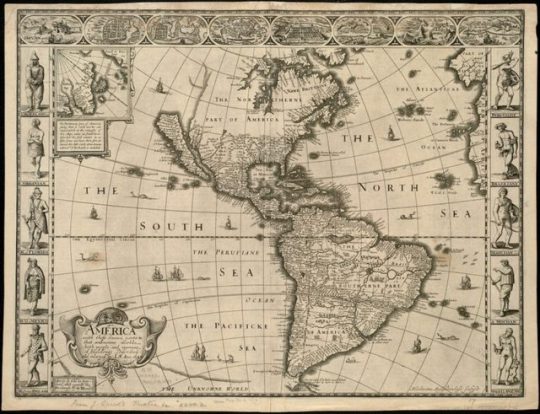
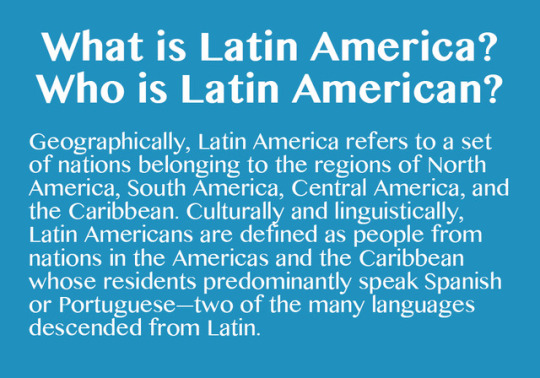



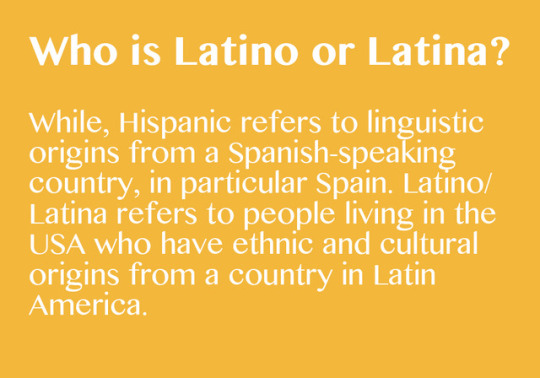
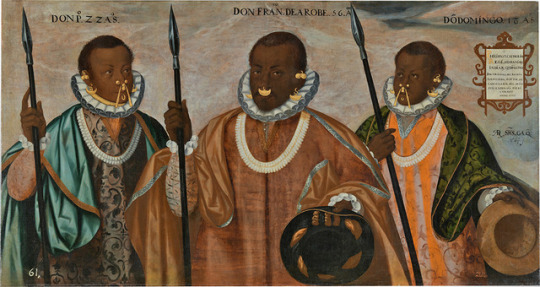

Latin American Identity Terms Explained
What is Latin America? Who is Latin American?
Geographically, Latin America refers to a set of nations belonging to the regions of North America, South America, Central America, and the Caribbean. Culturally and linguistically, Latin Americans are defined as people from nations in the Americas and the Caribbean whose residents predominantly speak Spanish or Portuguese—two of the many languages descended from Latin.
Who is Hispanic?
The term Hispanic was introduced by the US Census Bureau in 1970, after groups such as the National Council of La Raza advocated for the category as an alternative to classifying Mexican, Cuban, and Puerto Rican immigrants as “white.”
Today Hispanic covers people of a variety of ethnic identities who have origins in Spanish-speaking countries—basically Spain and all of Latin America (minus Brazil, where the official language is Portuguese). The US Census Bureau now counts both Hispanics and Latinos in the same category.
Who is Latino or Latina?
While, Hispanic refers to linguistic origins from a Spanish-speaking country, in particular Spain. Latino/Latina refers to people living in the USA who have ethnic and cultural origins from a country in Latin America.
And what about Latinx?
Spanish, among many other Latin languages, assign genders to nearly everything, including inanimate objects. Masculine words are considered gender neutral, and if one male-identified individual enters a group, the group suddenly becomes referred to by a masculine word. This is problematic for a number of reasons, most glaringly is that masculine words should not be considered gender neutral. The term Latinx is a response to these language constraints, and it provides an option to express gender identity that exist outside the constraints of the binary.
For more on this topic including the Chicanx movement and African and East Asian diaspora in Latin America read a full blog post here.
Pacific Standard Time: LA/LA is an exploration of Latin American and Latino art in dialogue with Los Angeles. Led by the Getty, Pacific Standard Time: LA/LA is the latest collaborative effort from arts institutions across Southern California.
1K notes
·
View notes